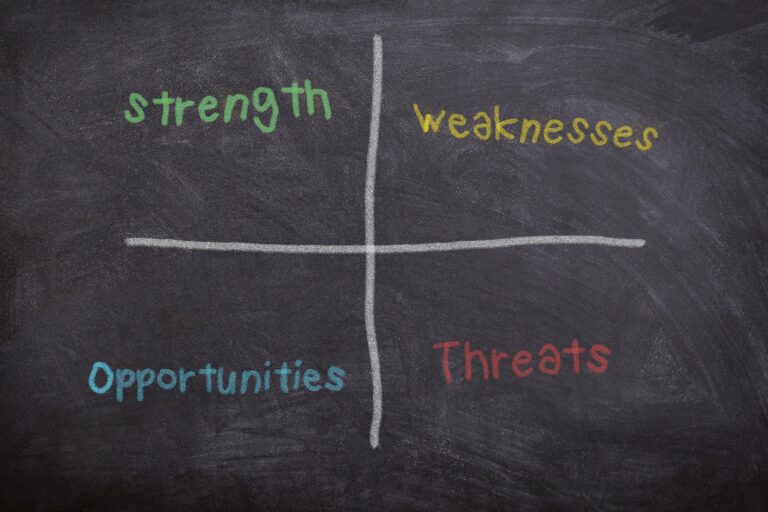What is SWOT Analysis?
SWOT Analysis is a common technique used to understand an organization’s position relative to the competitive environment within which it operates. SWOT stands for Strengths, Weaknesses, Opportunities, and Threats experienced by the company. This is a simple yet powerful tool that can be used to develop offensive and defensive strategies for your business.
Under strengths and weaknesses you should list your organization’s internal environment, which, perhaps with some effort, can be adjusted or adapted to better favour your organization. These factors are often associated with matters related to the team, location, intellectual property, barriers to entry, etc. Opportunities and Threats are related to external factors relating your organization and its industry. These represent a larger environment that cannot easily be controlled by your organization alone. However, the organization can take advantage of the opportunities and immunize itself against threats. Competitor footing, prices of raw material, laws and regulations of operating countries, and customer shopping trends and more can be considered as external factors.
Who should conduct the SWOT analysis?
People playing responsible roles across the business should be involved in the SWOT analysis. When a group of people from different perspectives within the company are involved, it becomes more effective – it is important that everyone has a seat at the table. It can either be a brainstorming session involving the organization and its people, or it can be conducted at a more serious and strategic level. A simple method can be pooling in ideas of employees under the four categories; Strengths, Weaknesses, Opportunities, and Threats, and then analyzing the responses together to come up with a strategy that accounts for the key insights.
Let’s find out what each of these categories could contain.
Strengths
These refer to the internal factors that have a positive impact on the organization’s competitiveness. These help you have the upper hand in the market and sustain your market share and growth. The following questions can be used as a guide to identifying the strengths of your organization.
- What are the organization’s processes that are successful and effective in staying ahead of the competition?
- What are the organization’s valuable assets (including people) that offer the organization an edge over the others?
- What are your unique selling propositions (USPs)?
- What is unique about your organization or brand that others cannot match?
Weaknesses
Are there factors that diminish the lead gained by your strengths? These negative factors in your company are defined as weaknesses and they can be identified by asking the following questions.
- What vulnerabilities does your business or product have, to competitors or changes in the external environment?
- What are the processes in the organization that are not efficient?
- What problems are faced by the employees within your organization?
- Is there any other reason why you lag behind your competitors, or cannot adapt as quickly as them?
Opportunities
External factors that contribute either directly or indirectly to the success of your organization fall under opportunities. Most of the time, these factors are changes in the external environment that you can make use of.
- Are there changes with respect to rules and regulations which happen to favour your organization?
- Do new trends in the market affect your business on a positive note?
- Is your organizational growth in line with market growth?
Threats
If there are external factors that can affect your business negatively, such factors fall under threats. Ask yourself questions like the following to understand if your organization is facing any threats.
- How does a potential competitor’s entry to the market affect you?
- Is your competitor(s) up-to-date with the latest technologies in a situation where you lag behind?
- Does that new market trend put your business at risk?
- Are consumer behavioral patterns negative?
Let’s look at a hypothetical SWOT Analysis done for a restaurant.
There are no hard and fast rules or methods of carrying out a SWOT analysis, as a SWOT diagram will differ from one business to another, depending on the industry. When this process is carried out and all the ideas are collected from the participants of the session, potential strategies can be developed based on the ideas. Figuring out ways to combat external factors with internal strengths is the next step of this process. Organizations can look for ways to use opportunities to enhance their strengths or means of exploiting opportunities using their strengths.
